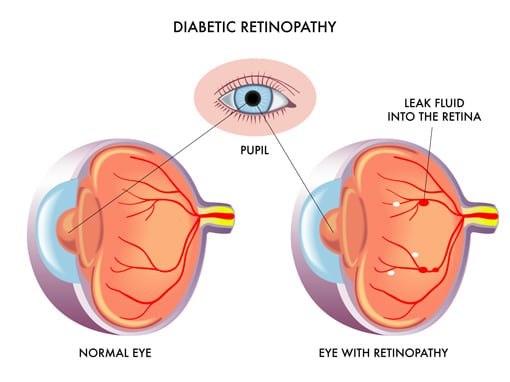Diabetic Retinopathy
Diabetic retinopathy is a complication of diabetes mellitus, which causes abnormalities in the tiny blood vessels nourishing the retina. Diabetic retinopathy is a leading cause of blindness among adults. Approximately 28% of current of adults with diabetes have retinopathy.
Early detection and management of diabetic retinopathy is important to prevent or slow the development of the more sight-damaging stages of the disease. With careful monitoring, treatment of diabetic retinopathy can usually be started before sight is affected. If you have diabetes, an annual comprehensive eye examination is the best protection against the progression of diabetic retinopathy. It is caused by changes in the blood vessels of the retina. In some people with diabetic retinopathy, blood vessels may swell and leak fluid. In other people, abnormal new blood vessels grow on the surface of the retina. The retina is the light-sensitive tissue at the back of the eye. A healthy retina is necessary for good vision.
If you have diabetic retinopathy, at first you may not notice changes to your vision. But over time, diabetic retinopathy can get worse and cause vision loss. Diabetic retinopathy usually affects both eyes.

Diabetic Retinopathy Stages
- Mild Nonproliferative Retinopathy. At this earliest stage, microaneurysms occur. They are small areas of balloon-like swelling in the retina’s tiny blood vessels.
- Moderate Nonproliferative Retinopathy. As the disease progresses, some blood vessels that nourish the retina are blocked.
- Severe Nonproliferative Retinopathy. Many more blood vessels are blocked, depriving several areas of the retina with their blood supply. These areas of the retina send signals to the body to grow new blood vessels for nourishment.
- Proliferative Retinopathy. At this advanced stage, the signals sent by the retina for nourishment trigger the growth of new blood vessels. This condition is called proliferative retinopathy. These new blood vessels are abnormal and fragile. They grow along the retina and along the surface of the clear, vitreous gel that fills the inside of the eye. By themselves, these blood vessels do not cause symptoms or vision loss. However, they have thin, fragile walls. If they leak blood, severe vision loss and even blindness can result.
All people with diabetes–both type 1 and type 2–are at risk. That’s why everyone with diabetes should get a comprehensive dilated eye exam at least once a year. The longer someone has diabetes, the more likely he or she will get Diabetic Retinopathy. Between 40 to 45 percent of Americans diagnosed with diabetes have some stage of Diabetic Retinopathy. If you have Diabetic Retinopathy, your doctor can recommend treatment to help prevent its progression.
Diabetic retinopathy is the most common diabetic eye disease and a leading cause of blindness in American adults. It is caused by changes in the blood vessels of the retina.
During pregnancy, Diabetic Retinopathy may be a problem for women with diabetes. To protect vision, every pregnant woman with diabetes should have a comprehensive dilated eye exam as soon as possible.
Schedule a Consultation
918-252-2020
We encourage you to schedule a consultation with Triad Eye Institute today. During our meeting, we will advise on whether or not you have Diabetic Retinopathy, as well as compose a custom treatment plan designed to achieve the clear vision you’ve always wanted. Call our office today and one of our seasoned staff members will be able to assist you.

